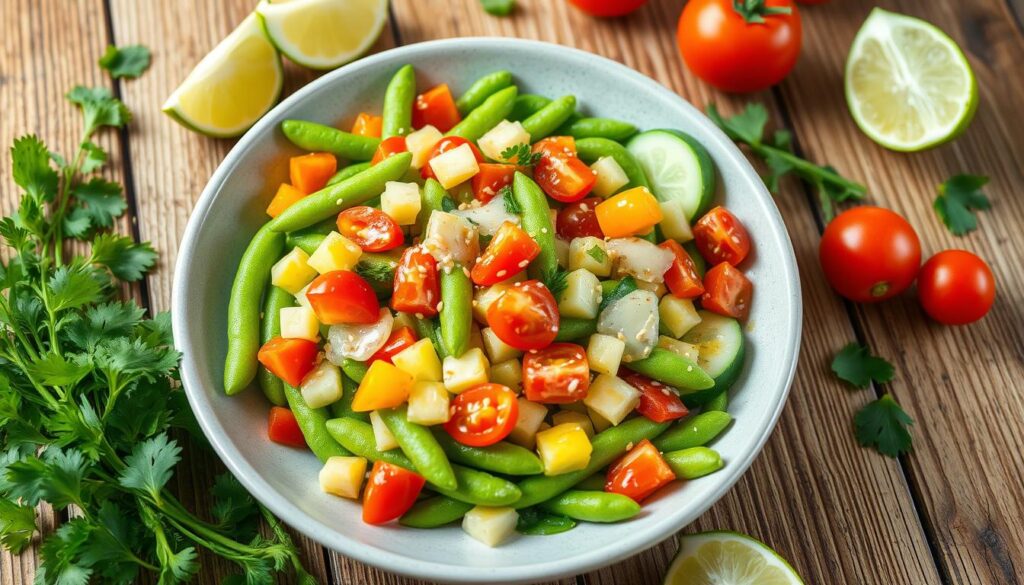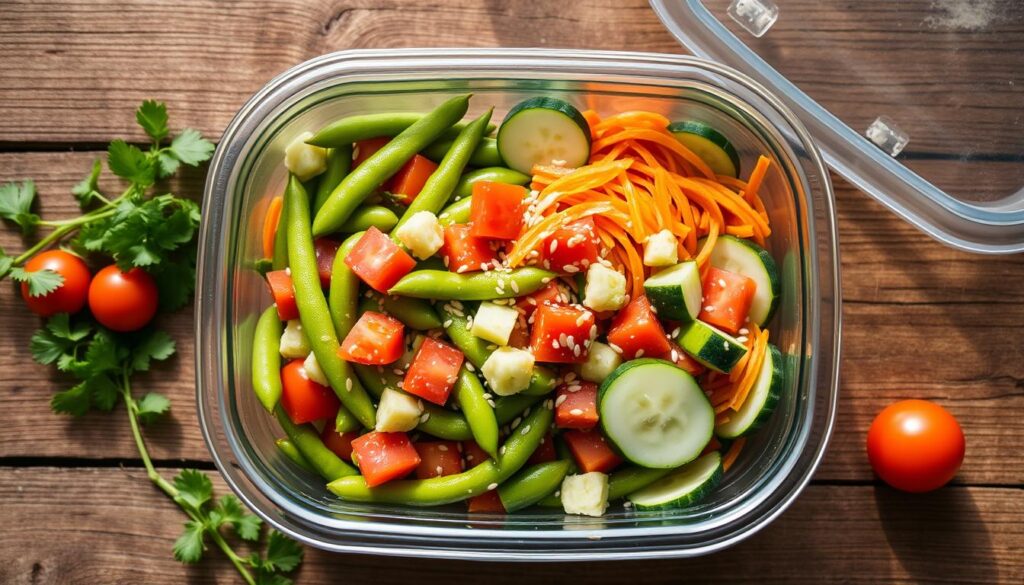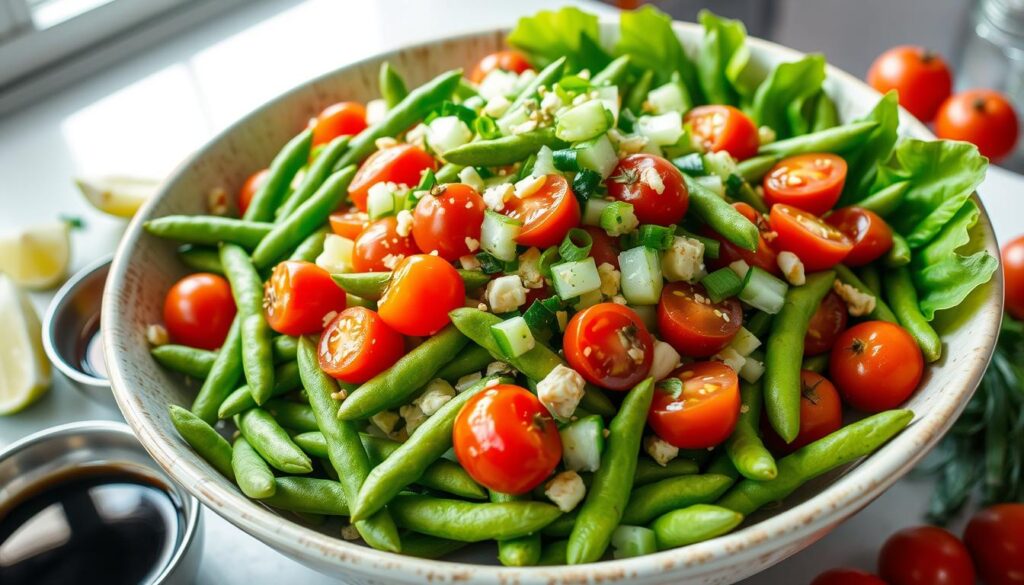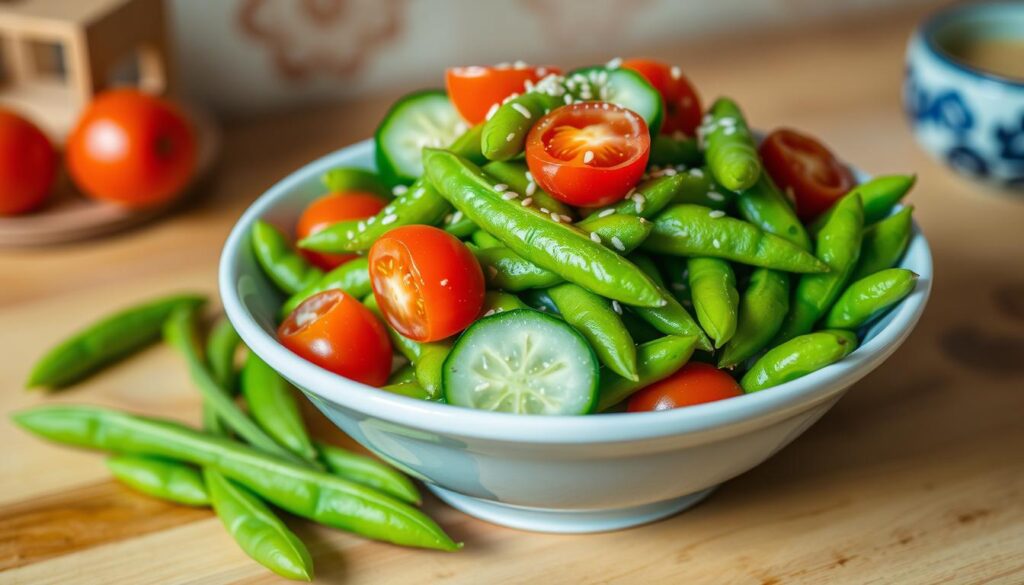The smell of steamed edamame beans fills the air, taking me back to Asia’s lively night markets. These green pods, full of nutrients, offer a tasty and healthy journey. This edamame salad is more than a side dish; it’s a celebration of Asian flavors and traditions.
Table of Contents
What Makes Edamame Salad a Perfect Healthy Choice
Edamame salad is a tasty side dish with many health benefits. It’s packed with nutrients, low in calories, and high in protein. This salad is a great choice for anyone looking for a healthy and filling meal.
Nutritional Benefits of Edamame Beans
The main ingredient in edamame salad is the edamame bean. These beans are full of vitamins and minerals. They include:
- Vitamin K, which is important for blood clotting and bone health
- Folate, a B vitamin that helps with fetal development and red blood cells
- Manganese, a mineral that helps with metabolism and fighting off free radicals
- Copper, which supports healthy nerves and the immune system
Low-Calorie Profile and High Protein Content
Edamame salad is also low in calories and high in protein. One cup of cooked edamame has about 188 calories. It’s a great choice for those watching their weight or wanting to stay healthy. Plus, it has about 17 grams of plant-based protein per cup. This helps you feel full and supports your health goals.
Essential Vitamins and Minerals
The edamame beans aren’t the only healthy part of this salad. The fresh veggies, herbs, and dressings add even more nutrients. This salad is a rich source of vitamins and minerals that boost your health and well-being.
The Origins and Cultural Significance of Asian-Inspired Salads
The story of Asian-inspired salads starts in East Asia. Here, fresh veggies, legumes, and spices are key. Edamame, or young soybeans, is a big hit in these salads. It comes from Japan and China.
Edamame’s rise in salads shows how food from the East meets the West. This mix has created many Asian edamame salad recipes. Each one highlights the special tastes and textures of edamame.
“The incorporation of edamame into salads has not only added a distinct Asian flair but also provided a nutritious and filling component to these dishes.”
Asian-inspired salads mean more than just food. They show the values and traditions of Asia. In many Asian cultures, salads are a way to celebrate nature’s gifts and balance flavors.
Exploring Asian edamame salad and its roots broadens our food world. It helps us appreciate the diversity of global cuisine.
Essential Ingredients for the Perfect Edamame Salad
Making a tasty edamame salad begins with picking the right ingredients. You need fresh produce and Asian pantry staples. Each part is key to a dish that tastes great and looks good.
Fresh Produce Selection Guide
The base of a great edamame salad is the quality of its fresh produce. Start with:
- Edamame beans, the star of the show
- Refreshing cucumbers, sliced or diced
- Vibrant cherry tomatoes, halved or quartered
- Crisp bell peppers, diced in various colors
- Fragrant scallions, thinly sliced
Asian Pantry Staples
To add real Asian flavors to your salad, make sure you have these:
- Soy sauce or tamari for a savory umami boost
- Rice vinegar to balance the acidity
- Sesame oil for its nutty, aromatic notes
- Fresh ginger, grated or minced, for a zesty punch
- Toasted sesame seeds to add crunch and visual appeal
Optional Add-ins and Variations
To make your edamame salad your own, try adding these:
- Crunchy water chestnuts, diced
- Shredded carrots for a pop of color
- Thinly sliced red onion for a savory bite
- Chopped cilantro or basil for a fresh herbal touch
- Cooked and cooled quinoa or brown rice for added substance
By choosing and mixing these ingredients, you’ll make a salad that’s full of flavor and color. Try different mixes to find your favorite!
Step-by-Step Preparation Guide
Making a tasty edamame salad is easy and can boost your cooking skills. It doesn’t matter if you’re new to cooking or have experience. Just follow these simple steps to make a colorful, Asian-style side dish that will wow your friends.
Gather the Ingredients
First, collect all the ingredients you need for your edamame salad. You’ll need fresh edamame beans, crunchy veggies like carrots, cucumber, and red bell pepper. Also, get some aromatic herbs like cilantro or green onions. And don’t forget a tasty dressing with Asian flavors.
Cook the Edamame
- Boil a pot of salted water.
- Add frozen edamame beans and cook for 3-5 minutes, until they’re tender but crisp.
- Drain the edamame and rinse with cold water to stop cooking.
- Pat the edamame dry with paper towels or a clean towel.
Prepare the Vegetables
- Thinly slice the carrots, cucumber, and red bell pepper.
- Finely chop the cilantro or green onions.
Assemble the Salad
In a big mixing bowl, mix the cooked edamame, sliced veggies, and chopped herbs. Pour the Asian-inspired dressing over the top. Gently toss to coat everything evenly.
Chill and Serve
Cover the salad and chill it for at least 30 minutes. This lets the flavors mix well. When you’re ready to serve, put the salad in a bowl or plate. Enjoy its fresh and vibrant taste.

The secret to a great edamame salad is using fresh, quality ingredients and following the right steps. With this guide, you’ll make a salad that highlights Asian flavors and textures beautifully.
Creating the Perfect Asian-Inspired Dressing
Making the perfect Asian-inspired dressing is key to making your edamame salad amazing. This dressing brings out the best in the salad’s fresh ingredients. It creates a perfect mix of tastes and textures.
Base Ingredients for the Dressing
The base of a great Asian salad dressing includes a few must-haves:
- High-quality rice vinegar, for a subtle tang
- Toasted sesame oil, to provide a nutty aroma and depth of flavor
- Tamari or soy sauce, for a savory umami note
- Fresh ginger, finely grated, to add a zesty kick
- Honey or maple syrup, to balance the acidity and create a harmonious blend
Balancing Flavors and Textures
The secret to a top-notch Asian salad dressing is finding the right balance. Start with a 3:1 ratio of rice vinegar to sesame oil. Then, adjust the other ingredients to your liking.
For a creamier edamame salad dressing, add a bit of mayonnaise or Greek yogurt. This makes the dressing smooth and velvety. It goes well with the salad’s crisp veggies and tender edamame.
Play with the ginger and sweetener levels to get the flavor just right. The dressing should enhance the salad, not overpower it.
“The key to a truly exceptional Asian-inspired salad dressing is finding the perfect balance of flavors and textures.”
Tips for Selecting and Preparing Fresh Edamame
Creating the perfect fresh edamame salad starts with the quality and prep of the edamame beans. As a home cook, I’ve learned a few key tips. These ensure your edamame is tasty, keeps its texture, and stays full of nutrients.
When shopping for fresh edamame, look for pods that are bright green and plump. They should be free of blemishes or discoloration. Avoid shriveled or dull pods. Choose locally grown or organic edamame for the best taste and nutrients.
To prepare edamame for salad, blanch them briefly in boiling water. They should turn vibrant green and be tender-crisp. Shock them in an ice bath to stop cooking and keep them fresh.
Frozen edamame is convenient, but fresh edamame tastes and feels better in salads. Frozen edamame loses some sweetness and gets a mealy texture. For the best flavor and texture, use the freshest edamame you can find.
| Characteristic | Fresh Edamame | Frozen Edamame |
|---|---|---|
| Flavor | Sweet, grassy, and vibrant | Slightly muted and less distinct |
| Texture | Firm, tender-crisp | Can become slightly mealy |
| Nutrient Retention | Preserves more vitamins and minerals | May lose some nutrients during freezing |
By following these tips, you’ll make a fantastic fresh edamame salad. It will be full of flavor and texture.
Innovative Ways to Customize Your Cucumber Edamame Salad
It’s easy to make your cucumber edamame salad special. Just add seasonal produce and protein-rich ingredients. This way, you can make a dish that’s both unique and delicious. Let’s look at some ways to make this Asian-inspired salad your own.
Seasonal Variations
Using fresh, seasonal ingredients is fun. You can change your recipes with the seasons. For example, in summer, add cherry tomatoes or bell peppers to your salad. In fall, try roasted butternut squash or kale for a nice contrast.
In winter, red cabbage or radishes can add color and crunch. This makes your salad interesting and fresh.
Protein Additions
To make your salad more filling, add some protein. Grilled chicken or tofu can be a good choice. Hard-boiled eggs or feta cheese add a creamy touch. For vegetarians, roasted chickpeas or tempeh are great options.
By trying different ingredients, you can make your cucumber edamame salad unique. Let your creativity run wild and enjoy the vibrant tastes of this dish.
Make-Ahead Tips and Storage Guidelines
Preparing your edamame salad ahead of time can save you a lot of time. It’s easy to keep it fresh and tasty for days. Just follow a few simple steps.
Meal Prep Like a Pro
Start by chopping the veggies and making the dressing up to 3 days early. Put the chopped ingredients in airtight containers in the fridge. Then, when you’re ready, just mix everything together and enjoy!
Storing Edamame Salad
- Keep the salad in an airtight container in the fridge for up to 4 days. It will stay fresh and crunchy.
- Keep the dressing separate to avoid a soggy salad. Add it just before serving.
- Freeze the salad for up to 2 months. Thaw it in the fridge overnight before eating.
| Storage Method | Shelf Life |
|---|---|
| Refrigerated (Assembled Salad) | Up to 4 days |
| Refrigerated (Dressing Separately) | Up to 7 days |
| Frozen | Up to 2 months |
With these easy meal prep and storing edamame salad tips, you can enjoy your salad all week!

Pairing Suggestions and Serving Ideas
Enjoying a fresh edamame salad opens up endless pairing options. You can match it with tasty main dishes and cool drinks. This way, you can make your meal more exciting and balanced.
Main Dish Combinations
Edamame salad goes great with many main courses. It adds a nice crunch and freshness. Try it with grilled salmon or teriyaki chicken for a tasty Asian meal. It also pairs well with beef bulgogi or vegetable stir-fries, balancing out the flavors.
Beverage Pairings
Choose drinks that match your edamame salad’s flavors. A crisp white wine like Riesling or Sauvignon Blanc is perfect. For something non-alcoholic, try a refreshing green tea or citrusy herbal drink. These can clean your palate between bites.
| Main Dish Pairings | Beverage Pairings |
|---|---|
| Grilled Salmon | Riesling |
| Teriyaki-Glazed Chicken | Sauvignon Blanc |
| Beef Bulgogi | Green Tea |
| Vegetable Stir-Fry | Herbal Infusion |
Make your edamame salad look good when you serve it. Use a wide, shallow bowl or platter to show off its colors and textures. Add some toasted sesame seeds or sliced scallions for extra flavor and looks.
Common Mistakes to Avoid When Making Edamame Salad
Making the perfect edamame salad seems easy, but even pros can slip up. I’ve learned from my mistakes to avoid common edamame salad tips and salad preparation mistakes. By dodging these errors, your edamame salad will be vibrant, tasty, and healthy.
Overcooking the Edamame
Cooking the edamame beans right is key. Overcooking makes them mushy and unappealing. Follow the package instructions and cook them until they’re tender but firm.
Improper Dressing Ratios
The dressing is what ties the flavors together. But finding the right mix can be hard. Too much oil or acid can drown the edamame, while too little dressing can make it taste bland. Try different ratios to find the perfect balance.
- Don’t use too much dressing, as it can make the salad soggy.
- Start with a small amount of dressing and add more as needed.
- Watch the acidity in the dressing, as too much can overwhelm the other flavors.
Neglecting Flavor Enhancers
While edamame and dressing are the base, adding flavor enhancers can elevate your salad. Try toasted sesame seeds, fresh herbs, or a bit of soy sauce to enhance the Asian flavors.

“Elevating your edamame salad is all about finding the right balance of flavors and textures.”
Avoiding these common mistakes will help you make a stunning edamame salad full of flavor. With practice, you’ll master this tasty Asian-inspired dish.
Health Benefits and Dietary Considerations
Adding edamame salad to your meals can bring many health benefits. These soybeans are packed with nutrients, making them a great choice for any meal.
Edamame salad is great for weight management. It’s low in calories but high in protein, helping you stay full. It also has fiber, which is good for your digestion.
Edamame is also good for your heart. It has antioxidants and omega-3 fatty acids that can lower cholesterol and heart disease risk. These nutrients are key for heart health.
If you’re on a special diet, edamame salad is a good choice. It’s gluten-free and fits well with vegetarian or vegan diets. But, people with soy allergies should be careful.
| Nutrient | Amount per 1 cup (155g) of Edamame |
|---|---|
| Calories | 188 |
| Protein | 17g |
| Fiber | 8g |
| Vitamin K | 31% of the Daily Value |
| Folate | 55% of the Daily Value |
Adding edamame salad to your meals is a tasty way to get more nutrients. It offers many health benefits for your body.
Time-Saving Shortcuts and Meal Prep Strategies
Making a tasty edamame salad doesn’t have to take a lot of time. I’ve found some shortcuts and strategies that make it easier. These help me enjoy the salad’s vibrant flavors with little effort.
Quick Assembly Methods
When I’m in a hurry, I use quick methods to make my edamame salad fast. I keep frozen edamame beans ready to go. I toss them with fresh veggies like carrots, cucumbers, and red bell peppers.
Adding my favorite Asian dressing makes it a quick and satisfying meal.
Batch Preparation Tips
On weekends or when I have more time, I prep big batches of salad parts. I roast edamame beans, chop veggies, and make extra dressing. This way, I can quickly make my salad whenever I need it.




1 thought on “Fresh Edamame Salad: A Vibrant Asian-Inspired Side Dish”